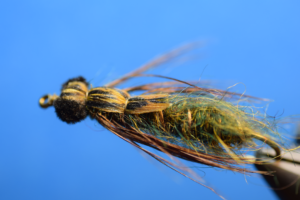Expert Advice
Summer Fly Fishing Tactics for Stillwater Trout
The months of July and August typically offer the warmest days of the year for much of Western Canada and the western states. It is also the time for summer family vacations and fishing is often a big part of these getaways. There are literally, thousands of inland lakes to choose from plus many offering waterfront camping opportunities which provide the perfect backdrop for a summer adventure as well as a chance to catch some trout.

Warming summer water temperatures make it a bit more challenging for the stillwater fly fisher. Trout and char leave the shallow water areas that they have been feeding in all spring and head to deeper water which is cooler and better oxygenated. This means the angler needs to focus their fishing efforts in water that is from about 20 feet in depth to sometimes in excess of 40 feet. The transition from the shallow water to the deeper water is called the drop-off zone. Drop-offs can range from gradual sloping angles to almost sheer cliff-like transitions to the deep water of the lake. The ideal drop-off has a gentle angle that provides lots of great feeding and resting habitat for the trout.

Prime food sources found along the drop-offs include leeches, dragonfly nymphs, damselfly nymphs, scuds or freshwater shrimp and mayfly nymphs. Floating line used with strike indicators or fished with long sinking tapered leaders are extremely effective when fishing the shallower areas of the lake but tackling the deeper depths brings full sinking lines of various densities into play. The sinking lines allow you to present your flies right along the lake bottom or anywhere in between the bottom and the surface of the lake. Sinking lines come in densities from Type 1 to Type 7. The number indicates the sinking rate of the line in inches/second. So a type 3 sinking line descends at 3 inches/second. Normally the deeper the water equates to using faster sinking lines.


The drop-off zone is also a great place to anchor and cast and retrieve flies using a variety of sinking lines as well as floating lines with indicators or floating lines with long sinking leaders. The boat can be anchored on the edge of the drop-off and flies can be fished out over the sloping bottom and retrieved back up the slope to the boat. Flies can also be suspended under an indicator which is set so that the pattern is suspended just off the bottom. This means using a leader that will often be in excess of 20 feet which can be frustrating for inexperienced casters. In this case, let the sinking lines get your flies to the bottom.
You can also anchor your boat parallel along the face of the drop-off and cast and retrieve patterns again just off the bottom. Gradually sloping drop-offs provide the best opportunities for this fishing position.

Leeches, dragonfly and damselfly nymphs and shrimp or scud patterns are go to patterns to cast and retrieve or suspend under a strike indicator. During the summer period trout are often more actively feeding during lower light conditions so this is a great time to fish early mornings and bring in a fresh fish for breakfast.

The last couple hours before dark are also a good time to be back out on the water searching for the big fish of the day. Water temperatures may drop a few degrees after the sun has left the water and that will often increase the feeding activity levels of the trout.

As a guide, seminar host, successful author, and retired fisheries biologist, you’ll be hard pressed to find a more passionate and influential angler in all of British Columbia than Brian Chan. Based out of Kamloops, BC, he enjoys spending time on local lakes when he isn’t reaching for the ends of the earth for his next adventure.


